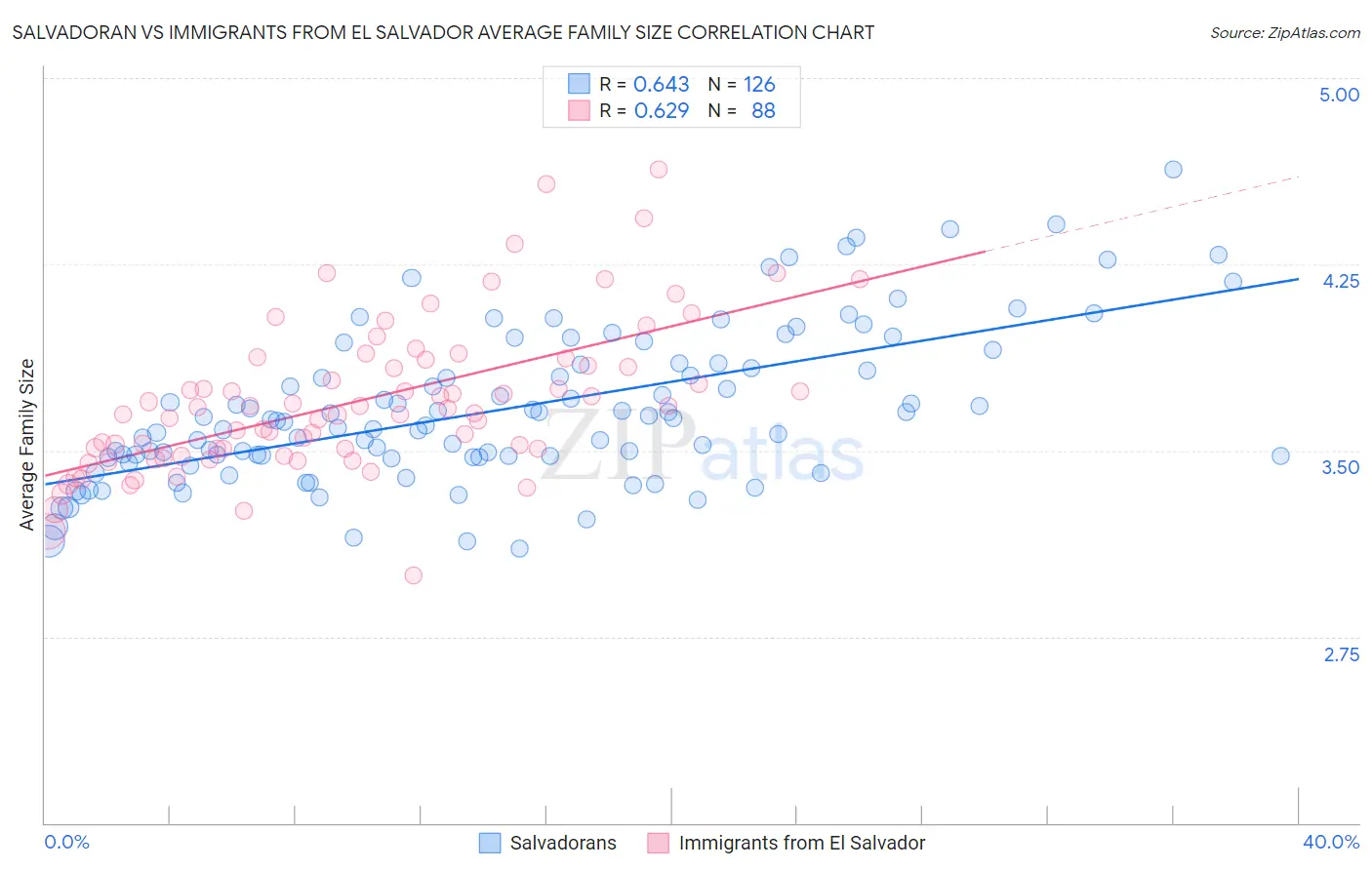Salvadoran vs Immigrants from El Salvador Average Family Size
COMPARE
Salvadoran
Immigrants from El Salvador
Average Family Size
Average Family Size Comparison
Salvadorans
Immigrants from El Salvador
3.48
AVERAGE FAMILY SIZE
100.0/ 100
METRIC RATING
18th/ 347
METRIC RANK
3.49
AVERAGE FAMILY SIZE
100.0/ 100
METRIC RATING
17th/ 347
METRIC RANK
Salvadoran vs Immigrants from El Salvador Average Family Size Correlation Chart
The statistical analysis conducted on geographies consisting of 398,698,929 people shows a significant positive correlation between the proportion of Salvadorans and average family size in the United States with a correlation coefficient (R) of 0.643 and weighted average of 3.48. Similarly, the statistical analysis conducted on geographies consisting of 357,696,345 people shows a significant positive correlation between the proportion of Immigrants from El Salvador and average family size in the United States with a correlation coefficient (R) of 0.629 and weighted average of 3.49, a difference of 0.25%.

Average Family Size Correlation Summary
| Measurement | Salvadoran | Immigrants from El Salvador |
| Minimum | 3.10 | 3.00 |
| Maximum | 4.63 | 4.63 |
| Range | 1.53 | 1.63 |
| Mean | 3.67 | 3.70 |
| Median | 3.62 | 3.66 |
| Interquartile 25% (IQ1) | 3.47 | 3.49 |
| Interquartile 75% (IQ3) | 3.85 | 3.85 |
| Interquartile Range (IQR) | 0.37 | 0.36 |
| Standard Deviation (Sample) | 0.31 | 0.30 |
| Standard Deviation (Population) | 0.31 | 0.30 |
Demographics Similar to Salvadorans and Immigrants from El Salvador by Average Family Size
In terms of average family size, the demographic groups most similar to Salvadorans are Mexican (3.48, a difference of 0.070%), Cheyenne (3.47, a difference of 0.11%), Ute (3.49, a difference of 0.34%), Yuman (3.47, a difference of 0.36%), and Tongan (3.49, a difference of 0.40%). Similarly, the demographic groups most similar to Immigrants from El Salvador are Ute (3.49, a difference of 0.090%), Tongan (3.49, a difference of 0.15%), Immigrants from Central America (3.49, a difference of 0.19%), Mexican (3.48, a difference of 0.32%), and Cheyenne (3.47, a difference of 0.36%).
| Demographics | Rating | Rank | Average Family Size |
| Inupiat | 100.0 /100 | #7 | Exceptional 3.63 |
| Immigrants | Yemen | 100.0 /100 | #8 | Exceptional 3.60 |
| Hopi | 100.0 /100 | #9 | Exceptional 3.60 |
| Spanish American Indians | 100.0 /100 | #10 | Exceptional 3.58 |
| Tohono O'odham | 100.0 /100 | #11 | Exceptional 3.53 |
| Immigrants | Mexico | 100.0 /100 | #12 | Exceptional 3.52 |
| Sioux | 100.0 /100 | #13 | Exceptional 3.52 |
| Immigrants | Central America | 100.0 /100 | #14 | Exceptional 3.49 |
| Tongans | 100.0 /100 | #15 | Exceptional 3.49 |
| Ute | 100.0 /100 | #16 | Exceptional 3.49 |
| Immigrants | El Salvador | 100.0 /100 | #17 | Exceptional 3.49 |
| Salvadorans | 100.0 /100 | #18 | Exceptional 3.48 |
| Mexicans | 100.0 /100 | #19 | Exceptional 3.48 |
| Cheyenne | 100.0 /100 | #20 | Exceptional 3.47 |
| Yuman | 100.0 /100 | #21 | Exceptional 3.47 |
| Apache | 100.0 /100 | #22 | Exceptional 3.46 |
| Immigrants | Fiji | 100.0 /100 | #23 | Exceptional 3.45 |
| Natives/Alaskans | 100.0 /100 | #24 | Exceptional 3.45 |
| Yakama | 100.0 /100 | #25 | Exceptional 3.45 |
| Native Hawaiians | 100.0 /100 | #26 | Exceptional 3.43 |
| Mexican American Indians | 100.0 /100 | #27 | Exceptional 3.43 |